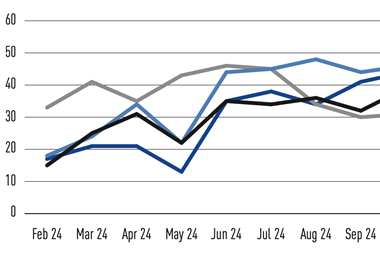In the 1950s, the Swedish parliament voted by a majority of one not to go the pension funding route. Liberal Party MP Bo Könberg has spent much of his parliamentary career fighting this decision. The question of pensions and retirement provision has been the most controversial issue of all through the years," he says.
Then, in the 1980s, the question arose as to whether the pay-as-you-go system could be maintained and a committee was established to examine the issues. "This produced good analysis, but no agreement."
In 1991, when he was the responsible cabinet minister, he got his opportunity. An all-party working group on pensions was established. "In August the next year, we reached agreement on basic principles between the four parties making up the government and the opposition social democratic group on the life income principle and that the change in entitlement be related to growth in nation al wealth."
In 1994 the guidelines were approved by parliament and, despite the change in government, they included the 2% funding element within the 18.5% contribution rate. "Funding was something the social democrats did not like but they accepted as part of the big compromise."
Könberg and his colleagues would like to see the funding element as large as possible. The 2% figure (later increased to 2.5%) came after experts looked at the demographics and entitlements and concluded 16-16.5% was about the right amount for the PAYG pension. "The idea behind funding is not to have all your eggs in one basket. The state fund may grow at 2% in terms of national wage growth, but maybe 3-5% annually for the funded part, so it will produce a better pension in the future," he says.
Könberg is now actively involved in the debate about the future of the AP funds of the National Swedish Pension Funds, the buffer funds built up of around Skr700m ($86m). These are invested through six funds, but over SKr600m of the assets are in the first three funds, invested 95% in bonds and mortgage loans and 5% in property; the other three funds can invest in shares and venture capital. In 1997, the three main funds paid out some Skr122bn in benefits, as against Skr88bn in contributions, the deficit of Skr34bn being more than covered by the Skr38bn in investment returns. In the 1980s, there was a surplus of contributions to payments.
There is no doubt that the AP funds are going to be reduced. Its 1997 annual report refers to a possible Skr300m being transferred as a result of the move of early retirement and survivor pensions to the national budget under the new system.
At AP, Anders Rahmn, head of planning, says that "at present they are calculating the full effects of the pension reforms on the funds. Our view is the transfer could be smaller than the Skr300m."
The AP funds will be used to act as the buffer funds for the 16% contributions to the new system, higher than the current rate of 14% and the new seventh fund will be set up to manage the amounts of those who do not make a choice under the Premium Pensions Authority (see facing page).
Könberg says the amount finally transferred from AP will depend on the "break" discussions. These are about the question whether if untoward economic conditions prevailed it would be possible to introduce "an automatic mechanism reducing the indexation of the pension rights and pension paid out". This break would occur only in exceptional circumstances when the costly indexation of pensions to earnings came under intolerable strain and would be a temporary measure. "This does relate to how much can be taken out of the AP buffer fund now," he says.
The idea is that the break would be automatic. "This is so that it would be immunised from political interference - an aim shared by all the political parties," he adds.
AP also wants revised investment guidelines, says Rahmn. "We look forward to getting more liberal rules about investing more in equities and in other markets." But the debate on this is likely to be very much a political one. Earlier this year, a parliamentary report commissioned from the Mercer consulting group showed up gaps in the investment process and strategies at AP, which will doubtless be part of the discussion on the revised guidelines for AP's strategy."












No comments yet